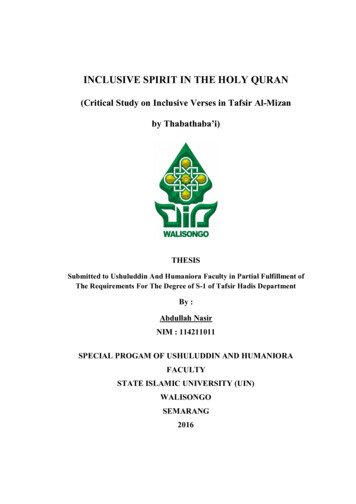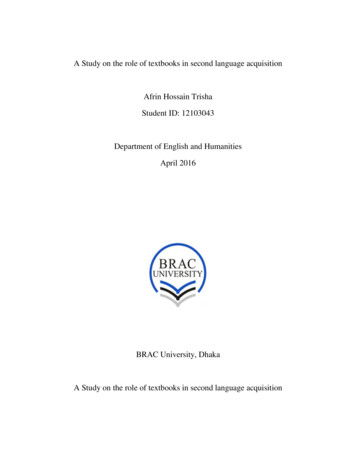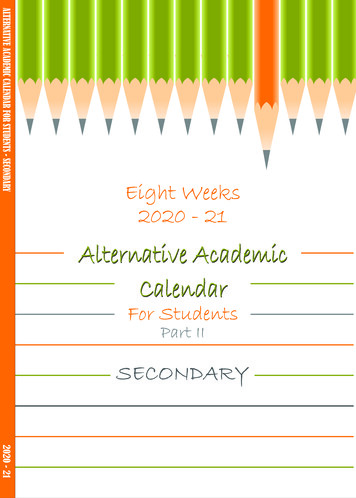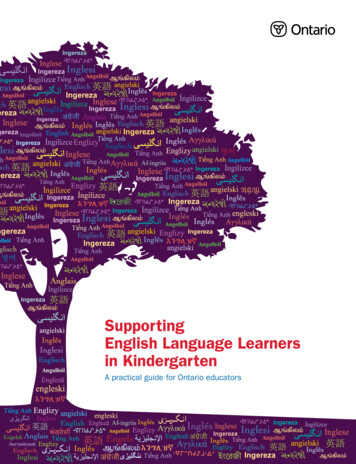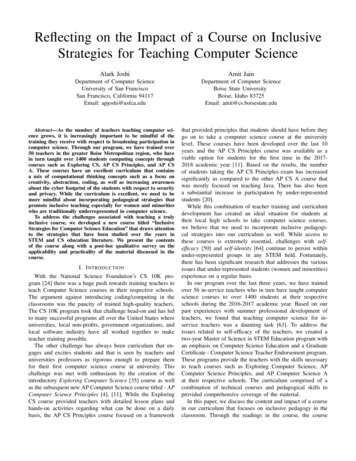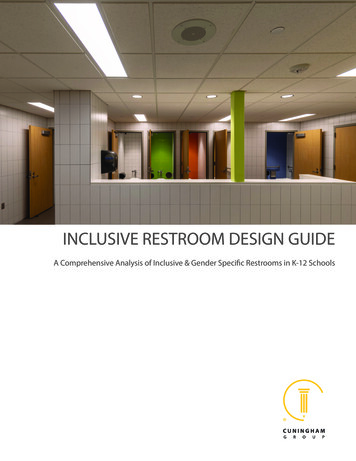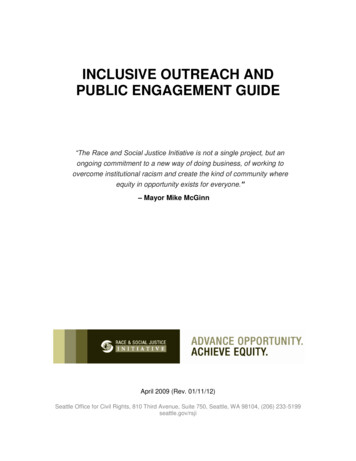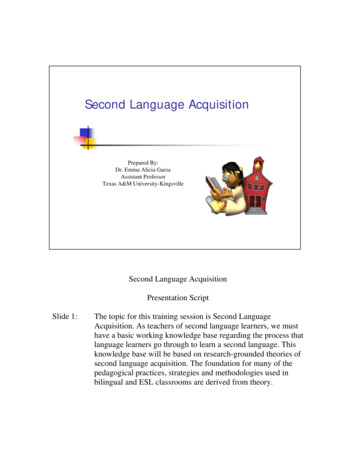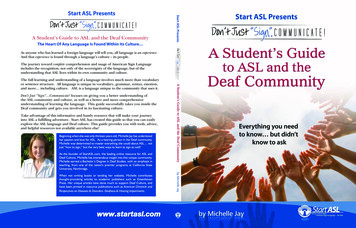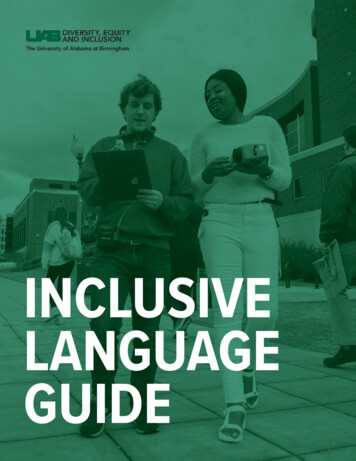
Transcription
INCLUSIVELANGUAGEGUIDE1
Inclusive language is an integral tool in our pursuit of inclusive excellence. Our effortsto foster an environment that values and welcomes diversity of thought, identity andexperience are rendered futile without a commitment to inclusive language. The use ofterminology, pronouns, and descriptors that honor the members within the UABenterprise and the communities we serve is vital in the execution of our university’sShared Values and Strategic Diversity Plan.This guide, created by the Office of the Vice President for Diversity, Equity andInclusion, is a living document that will be revised periodically to align with current bestpractices in the field of Diversity, Equity and Inclusion. It is designed to be the catalystfor implementing a more holistic and intersectional approach to communicating verballyand in written form. We hope that users will find it especially useful when referencingminoritized and marginalized identities, populations, and communities.We invite you to review this document for guidance in preparing course syllabi, annualreports, press releases, lectures and presentations, etc. Thank you for your continuedcommitment to upholding the Shared Value of Diversity and Inclusiveness at theUniversity of Alabama at Birmingham.Warmly,Paulette Patterson Dilworth, Ph.DVice President for Diversity, Equity, and Inclusion2
“Words carry meaningand powerThe ways in which we refer to individuals and groups ofpeople can be evidence of respect—or they can conveydisregard or scorn. Historic and systemic injusticetoward some groups has created bias and prejudicethat seeps into everyday language. Because languageuse is deeply ingrained, mirroring patterns and culturalnorms learned from infancy, we may not always beconscious of the harm our words can inflict, especially ifwe belong to a group holding power.- National Assembly of State Arts Agencies (NASAA)3
DEFINING DIVERSITY, EQUITY AND INCLUSION AT UABDiversity is a defining feature of Alabama’s and UAB’s past, present, and future; and refers to the variety of personal experiences, values, and worldviews that arise from differences of culture and circumstance. Such differences include race, ethnicity, gender, age, religion, language, abilities/disabilities, sexual orientation, socioeconomic status, geographic region, andmore.Equity is the guarantee of fair treatment, access, opportunity, and advancement for all students, faculty, and staff in everystage of UAB’s education and career development, while at the same time striving to identify and eliminate barriers that haveprevented the full participation of marginalized groups.Inclusion is the act of creating an environment at UAB in which any individual or group can feel welcome, respected, supported, and valued. An inclusive climate embraces differences and offers respect in words and actions so that all people can fullyparticipate in the University’s opportunities.Language, as a facet of culture, is ever evolving and transforming to better articulate and represent our diverse identities. Thisdocument will be reviewed and revised on a semi-annual basis to demonstrate our on-going commitment to inclusive excellence. If you have any suggested additions or feedback, please email inclusion@uab.edu.RACEIt is important to note that race and ethnicity are not the same. According to the American Sociological Association, “race”refers to physical differences that groups and cultures consider socially significant, while “ethnicity” refers to shared culture,such as language, ancestry, practices, and beliefs. Socially and culturally, race and ethnicity are integral threads of a largertapestry.It’s a human-invented classification and socially constructed system. It was invented as a way to define physical differencesbetween people, but has more often been used as a tool for oppression and violence. (McAfee, 2017)Race is understood by most people as a mixture of physical, behavioral and cultural attributesThe idea of “race” originated from anthropologists and philosophers in the 18th century, who used geographical location andphenotypic traits like skin color to place people into different racial groupings. That not only formed the notion that there areseparate racial “types” but also fueled the idea that these differences had a biological basis.That flawed principle laid the groundwork for the belief that some races were superior to others — creating global powerimbalances that benefited white Europeans over other groups (Bryce, 2020)AAPIAsian American and Pacific IslanderAMERICAN INDIAN AND ALASKA NATIVEThe most inclusive and accurate term to use to refer to those who inhabited land that became the United States (or, previously, territories) is American Indian and Alaska Native. This is inclusive of terms such as American Indian, Alaska Native, Hawaiian Native, Native American, Native People, and Indigenous People.American Indian and Alaska Native cultural identification is place-based, diverse, and sociocultural. Always ask someone howthey prefer to be identified, including Hawaiian Natives.The person may prefer that you refer to them by their tribally specific nation. If a tribal name is used, ask for a phonetic spelling of the name.API4
Asian and Pacific IslanderAPIDAAsian, Pacific Islander, And Desi AmericanASIANAsian includes “a person having origins in any of the original peoples of the Far East, Southeast Asia, or the Indian subcontinent including, for example, Cambodia, China, India, Japan, Korea, Malaysia, Pakistan, the Philippine Islands, Thailand, andVietnam.”Asian category is something that got built up over time, and based on the kinds of immigrants the United States excludedfrom entering the country, starting with Chinese immigrants in 1882, and continuing with more and more Asian countries, until1917 when Congress created the Asiatic Barred Zone.BLACK/AFRICAN AMERICAN“An American of African and especially of Black African descent.”There was a time when being Black in America meant you were most likely descended from one or more enslaved Africanswho had survived the trans-Atlantic slave trade. However, as the number of African and Caribbean blacks immigrating to theUSA has increased, so have the chances that someone who identifies as black or African American is a first- or second-generation immigrantNot all Black persons are African-American, and not all African-Americans are black. Use caution in using these terms interchangeably.For example:African-American is hyphenated when it is used as a compound adjective.i)The Black Student Union held an event to educate the community on African-American holiday traditions.African American is not hyphenated when African is an adjective modifying American.ii)As a proud African American, Tanya was excited to participate in San Antonio’s Martin Luther King Jr. March.When an individual or group uses Black to identify their race or ethnicity, Black should be capitalized. This holds especiallytrue when a group from multiple countries of origin—such as a group of African-Americans and Black Africans together.iii)The Kente ceremony celebrated honor, community, and connections for Black Tigers.When describing an object or referencing the color, not in reference to race or ethnicity, black should be lowercase.BLACK, INDIGENOUS, PEOPLE OF COLOR (BIPOC)Black, Indigenous and People of colorExpansion of People of Color. The other two letters, for Black and Indigenous, were included in the acronym to account forthe erasure of black people with darker skin and Native American people.Some pushback to the term is that it groups many separate identities into one group. Janus Adams, a historian who was oneof the first children to desegregate the New York City public schools, argues that BIPOC is “a distraction.”“Everyone but White people lose their identity. White people keep their identity. White people keep their racial/cultural,nation-state, heritage identities, but Black people, Indigenous people, Asian people, Latino people all get subsumed intosomething.”DESI AMERICAN5
“Desi” as a noun or adjective has become the typical way for people of South Asian ancestry to identify members of their diaspora. With South Asian-Americans like Ms. Davuluri achieving more prominence in popular culture, “desi” will no doubt become a more widely known buzzword as well. The word comes from Hindi, with roots in ancient Sanskrit. It originally referredto someone or something native to a certain country, or “desh.Anyone with heritage from the subcontinent—India, Pakistan or Bangladesh—can identify as a “desi” and partake in “desi”culture.DOMINANT vs. SUBORDINATERefers to a group considered dominant (systematically advantaged by the society because of group membership) and agroup considered subordinate or targeted (systematically disadvantaged)Dominant groups, by definition, set the parameters within which the subordinates operate. The dominant group holds thepower and authority in society relative to the subordinates and determines how that power and authority may be acceptablyusedBeing born another race/color, woman, and homosexual can be labeled as subordinate identities because they are not aswidely accepted as their counterparts.EAST ASIANEthno-cultural term referring to the peoples, cultures, nations, languages, and histories of the eastern portion of the continentAsia.Countries Include:ChinaKoreaJapanVietnamETHNICITYEthnicity recognizes differences between people mostly on the basis of language and shared culture.“A sense of common ancestry based on cultural attachments, past linguistic heritage, religious affiliations, claimed kinship, orsome physical traits.”ETHNICITY VS. RACERace is a social construct that is not universal, so one must be careful not to impose racial labels on ethnic groups.Be sure that the racial and ethnic categories you use are as clear and specific as possible.For example, instead of categorizing participants as Asian American or Hispanic American, you could use more specific labelsthat identify their nation or region of origin, such as Japanese American or Cuban American. Use commonly accepted designations (e.g., census categories) while being sensitive to participants’ preferred designation.Examples of ethnicity include being Indian, Jewish or Asian, regardless of race. So a female born to Japanese parents inAtlanta might consider herself as racially Asian, but as ethnically Japanese, American, Japanese-American or even just American. (Cornell & Hartman, 2020)HISPANICHispanic, which centers language, refers to Spanish-speakers and thus excludes people of Brazilian descent because Portuguese and Brazilian Portuguese are the primary languages of Brazil.Hispanic refers to anyone from Spain or Spanish-speaking parts of Latin America. It, therefore, promotes Spanish heritage,something many oppose because of the violent ways that they colonized certain countries and the erasure of Afro-Latinos6
and Indigenous people. Grace Flores-Hughes is the government official and Latina policy maker credited with coining theterm.LATINOLatino refers to people from the Spanish and Portuguese-speaking countries of Latin America, but it does not include thosefrom Spain or Portugal. This word, however, typically doesn’t make room for people from Latin America whose countries werenot colonized by Spain or Portugal, leaving out Belizeans and Haitians.LATINXLatinx, too, purports to solve a problem of implied gender. True, gender marking in language can affect thought. But that issueis largely discussed among the intelligentsia. If you ask the proverbial person on the street, you’ll find no gnawing concernabout the bias encoded in gendered word endingsRelating to people of Latin American origin or descent (used as a gender-neutral or non-binary alternative to Latino or Latina)Gender-neutral term that young people were using because they were “tired of reaffirming the patriarchy inherent in language.” For example: In Spanish, a group of women is referred to as Latinas, while a group of men or a mixed group — evenone that is mostly women — is a group of Latinos. Feminists might balk at this the same way they’d balk at using he as adefault pronoun or referring to mixed groups as “guys” but never “gals.” The subtext is the same: It’s a man’s world, you ladiesare just in it (Mora, 2018)MARGINALIZETo relegate to an unimportant or powerless position within a society or group, to the metaphorical margins of society. It isused to replace stigmatizing language such as ‘minority’. Marginalized acknowledges that social identities are either centeredor othered in a society. Example: “We are protesting laws and policies that marginalize women.”NATIONALITYRefers to the Nation State that one was born intoMINORITIZEDGroups in any society that are defined as “minorities’ by a dominant group that is numerically larger than the ethnic group.This involves a power relationship between dominant and minoritized groups who often prefer not to be labeled as a ‘minority’ because of the suggestion that they are somehow subordinate to the larger dominant group.Highlights the social oppression that minoritized individualsOther relevant uses: Marginalized, MarginalPERSON OF COLOR, PEOPLE OF COLOR, STUDENTS OF COLORA person or people of color can identify with any race or ethnicity, and their identity can be respected through this term. Besure to consider all communities of color through multiracial perspectives. Use “people of color” in place of “minorities” whereappropriate.Do not use the term “colored person/people.”“People of color” is a term primarily used in the United States and Canada to describe any person who is not white. It doesnot solely refer to African-Americans; rather, it encompasses all non-white groups and emphasizes the common experiencesof systemic racism,7
“If you talk to a man ina language he understands,that goes to his head.If you talk to him in hislanguage, that goes tohis heart.- Nelson Mandela8
In the late 20th century, the term “person of color” was adopted as a preferable replacement to “non-white.” Unfortunately,the contrast pits all people who have a “color” against people who do not have a color or who possess “whiteness.”it is important to recognize that while “people of color” reaffirms non-whiteness, many people don’t like the term becausethey feel “it lumps all of us together.”SOUTH WEST ASIAN/NORTH AFRICANSWANA will eliminate the need for the “Middle Eastern” and “North African” subcategories, which were previously listed under the parent category of “White/Caucasian” and thus not tracked by the university. (Yoder, 2013)Roughly 3 million people of Southwest Asian, Middle Eastern or North African descent live in the United States, according to aLos Angeles Times analysis of U.S. Census Bureau data. (Parvini, 2018)WHITEA person having origins in any of the original peoples of Europe, the Middle East, or North Africa.GENDERRefers to the socially constructed roles, behaviors, activities, attributes and opportunities that any society considers appropriate for individuals on a spectrum of feminine and masculine.Gender does not exist only in binary terms like boy and girl or man and woman. There are many ways that someone canidentify as it relates to gender. See Gender Expansive for more information.BIOLOGICAL SEXRefers to anatomical, physiological, genetic, or physical attributes that determine if a person is male, female, or intersex.These include both primary and secondary sex characteristics, including genitalia, gonads, hormone levels, hormone receptors, chromosomes, and genes.Often also referred to as “sex,” “physical sex,” “anatomical sex,” or specifically as “sex assigned at birth.”Biological sex is often conflated or interchanged with gender, which is more social than biological, and involves personalidentity factors as well.When someone’s biological sex is in alignment with their socially constructed gender, that person would be identified asCis-Gender. (see Cis-gender)CISGENDERRefers to an individual whose gender identity aligns with the one typically associated with the sex assigned to them at birth.GENDER EXPANSIVEAn umbrella term sometimes used to describe people that expand notions of gender expression and identity beyond what isperceived as the expected gender norms for their society or context. Some gender-expansive individuals identify as a man ora woman, some identify as neither, and others identify as a mix of both.Gender-expansive people feel that they exist psychologically between genders, as on a spectrum, or beyond the notion ofthe man/woman binary paradigm, and sometimes prefer using gender-neutral pronouns9
They may or may not be comfortable with their bodies as they are, regardless of how they express their gender.GENDER EXPRESSIONthe external display of one’s gender, through a combination of clothing, grooming, demeanor, social behavior, and other factors, generally made sense of on scales of masculinity and femininity. Also referred to as “gender” presentation.This communication may be conscious or subconscious and may or may not reflect their gender identity or sexual orientation.While most people’s understandings of gender expressions relate to masculinity and femininity, there are countless combinations that may incorporate both masculine and feminine expressions—or neither—through androgynous expressions.An individual’s gender expression does not automatically imply one’s gender identity.GENDER IDENTITYInternal perception of one’s gender, and how they label themselves, based on how much they ender to be.Often conflated with biological sex, or sex assigned at birth.GENDER PRONOUNS (also known as Preferred Gender Pronouns)A personal gender pronoun, or PGP—sometimes called proper gender pronoun—is the pronoun or set of pronouns that anindividual personally uses and would like others to use when talking to or about that individual.In English, the singular pronouns that we use most frequently are gendered, so some individuals may prefer that you usegender neutral or gender-inclusive pronouns when talking to or about them. In English, individual use they and their as gender-neutral singular pronouns.Replaces the term Preferred Gender Pronoun, which incorrectly implies that their use is optional.GENDER PRONOUNS (also known as Preferred Gender Pronouns)A personal gender pronoun, or PGP—sometimes called proper gender pronoun—is the pronoun or set of pronouns that anindividual personally uses and would like others to use when talking to or about that individual.In English, the singular pronouns that we use most frequently are gendered, so some individuals may prefer that you usegender neutral or gender-inclusive pronouns when talking to or about them. In English, individual use they and their as gender-neutral singular pronouns.Replaces the term Preferred Gender Pronoun, which incorrectly implies that their use is optional.GENDER VARIANTA term, often used by the medical community, to describe individuals who dress, behave, or express themselves in a way thatdoes not conform to dominant gender norms. (See gender expansive.)People outside the medical community tend to avoid this term because they feel it suggests these identities are abnormal,preferring terms such as gender expansive and gender creative.LIFESTYLEA negative term often incorrectly used to describe the lives of people who are LGBTQ . Some dislike this term because itimplies that being LGBTQ is a choice.10
TRANSGENDEROften shortened to trans. A term describing a person’s gender identity that does not necessarily match their assigned sexat birth. Transgender people may or may not decide to alter their bodies hormonally and/or surgically to match their genderidentity.This word is also used as an umbrella term to describe groups of people who transcend conventional expectations of genderidentity or expression—such groups include, but are not limited to, people who identify as transsexual, genderqueer, gendervariant, gender diverse, and androgynous.TRANSGENDER OR TRANSGENDERED?Terms like Transgender and Cisgender would never be referenced as past tense with the -ed suffix. These words are adjectives, not nouns. Adjectives do not have a tense. Additionally, transgendered suggests that being trans is something thathappens to someone, as opposed to an identity someone is born with.TRANS MAN/WOMAN VS. TRANSMAN/TRANSWOMANA trans man is someone who identifies as a man but was designated female at birth. A trans woman is someone who identifies as a woman but was designated male at birth. Some trans people prefer to leave the word transgender or trans outaltogether, since they only identify as a man or woman.Writers shouldn’t use “transman” or “transwoman.” The word trans is an adjective that helps describe someone’s genderidentity, and it should be treated like other adjectives. Merging the adjective and the noun risks suggesting that a trans manor woman is more (or less) than just a man or just a woman, which goes against how many trans people identify themselves.Common Acronyms:AMABAcronym meaning Assigned Male at Birth. AMAB people may or may not identify as male some or all of the time. (See Gender)AFABAssigned female at birth (or AFAB): Acronym meaning Assigned Female at Birth. AFAB people may or may not identify asfemale some or all of the time.FTM/F2MA trans male/masculine person who was assigned female at birth.MTFA trans female/trans feminine person who was assigned male at birth. Often considered an over medicalized and somewhatoutdated term.TRANSSEXUALA less frequently used—and sometimes misunderstood—term which refers to people who use (or consider using) medicalinterventions such as hormone therapy or gender-affirming surgeries (GAS), also called sex reassignment surgery (SRS) orpursue medical interventions as part of the process of expressing their gender.11
Some people who identify as transsexual do not identify as transgender and vice versa.Transsexual is considered by some to be outdated or possibly offensive.What is the key difference between Transsexual and Transgender?The word Transgender refers to people who identify differently from their biological sex. For example, a transgender personwho is biologically female may feel that a male identity is a better fit and take the following steps: Use a male name instead of a female name. Use male pronouns instead of female pronouns. Dress as a man. Engage in activities that are typically associated with men in that culture.A Transsexual is a person who physically transitions from male to female or vice versa.She/He/They might take hormones to suppress the characteristics of the biological gender or promote the characteristics ofthe desired gender.Transsexuals may also decide to have gender reassignment surgery, in which – to the extent that is possible – the anatomicalfeatures of the biological gender are removed and the features of the desired gender are added.These definitions are not strict, however. Some feel that the word transsexual should not always refer to physical changes.Additionally, some transsexuals no longer refer to themselves as such after they have finished their transition. They call themselves either men or women.It is important to recognize that you should use the language that one uses for themselves when referring to someone inspeech or writing. Gender identity can be as unique to an individual as their finger print; never make assumptions about gender based on presentation or stereotypes of gender.SOCIOECONOMIC STATUS (SES)Diversity, equity and inclusion at UAB extends to include those who are first-generation college students, as well as thosefrom low-income, underrepresented and underserved populations. Students from these backgrounds may find it challengingto pay for college and afford the basic needs that tuition, room, and board do not provide. Some of those students may alsobe supporting their families by working while being part- or full-time students.FIRST-GENERATION/FIRST-GENERATION (COLLEGE) STUDENT/FIRST GENERATIONA first-generation college student is a student whose parents’ highest educational level is a high school diploma. A parent orparents may have attended college but did not obtain a degree.First-generation is hyphenated when used as an adjective, as in: first-generation student. First generation goes without thehyphen when “first” is the adjective modifying generation, as in: The students were the first generation to use the athleticfields for graduation.PELL-ELIGIBLEPell-eligible students are eligible to or are receiving the federal Pell grant because they or their families are considered by theU.S. government as low-income. Pell-eligible is not a substitute for low-income, as not all low-income students are Pell-eligible(eligibility is determined by citizenship or green card status).UNDERREPRESENTEDUnderrepresented students, faculty, or alumni are from racial, ethnic, and socioeconomic populations that have been historically and are disproportionately represented in higher education. Underrepresentation can also include first-generationcollege students.12
UNDERSERVEDThose who are low-income and historically underrepresented can be considered underserved, but should be substantiatedby understanding background. Underserved often includes a nod to minority, marginalized populations or first-generationstudents.LAWSADA – AMERICANS WITH DISABILITIES ACTA law passed in 1990 that prohibits discrimination against people with disabilities in employment, transportation, public accommodation, communications and governmental activities. The ADA also establishes requirements for telecommunicationsrelay services.TITLE VILegislation passed as part of the Civil Rights Act of 1964 prohibits discrimination on the basis of race, color and national originin programs and activities receiving federal financial assistance.TITLE VIILegislation passed as part of the Civil Rights Act of 1964 that prohibits employment discrimination based on race, color, religion, sex and national origin.TITLE IXA comprehensive federal law that prohibits discrimination on the basis of sex in any federally funded education program oractivity.MEDICAL DIAGNOSES/PEOPLE WITH DISABILITIESACCOMMODATION OR REASONABLE ACCOMMODATIONAny change in the working or learning environment or the way things are done that enables a person to enjoy equal opportunity. Reasonable accommodations may be requested based on religion or disability.ACCESSIBLE, ACCESSIBILITYLocations, spaces, events, and other collateral are referred to as accessible when they meet criteria for use by disabled andnondisabled people alike.Accessibility may also include accounting for individuals who communicate in different languages, have hearing or visionimpairments, and other cognitive and learning disabilities.AWARE (Always Working to Advocate, Retain & Employ)The AWARE program at UAB provides disability-management services when an employee’s job is affected by a physical,mental, or emotional impairment. Through a unique partnership between UAB and the Alabama Department of RehabilitationServices (ADRS), the AWARE Program assists current employees and their departments, job seekers going through the application process, veterans, and employees returning from long-term disability or medical leave. In addition, the AWARE Programcoordinates requests for reasonable accommodations under the Americans with Disabilities Act.DEAFSome people with mild or moderate hearing loss may affiliate themselves with the Deaf community and prefer to be referredto as “deaf” instead of “hard of hearing.”13
Alternatively, some who are deaf and don’t have a cultural affiliation to the Deaf community may prefer the term “hard of hearing.Lowercase when referring to a hearing-loss condition or to a deaf person who prefers lowercase. Capitalize for those whoidentify as members of the Deaf community or when they capitalize Deaf when describing themselves.“Deaf” should be used as an adjective, not as a noun; it describes a person with profound or complete hearing loss. Otheracceptable phrases include “woman who is deaf” or “boy who is hard of hearing.DISABILITY SUPPORT SERVICES AT UABDisability Support Services (DSS) is committed to making UAB programs and services accessible to students with disabilities.To prevent discrimination based on disability in all UAB student programs and services, the primary goal of DSS is to ensurean accessible university environment by working with students, faculty, staff and community agencies to provide appropriateaccommodations.DISABLEDAs an adjective, disabled may refer to a person or persons whose disability is central to the story being told (a disabled person). Disabled should never be used without people-first language, nor as a noun.If needing to also reference those without a disability, “nondisabled” is acceptable. Do not use “able-bodied” or “normal.”A disability is generally defined as a condition that restricts a person’s mental, sensory, or mobility functions to undertake orperform a task in the same way as a person who does not have that disability.DIFFERENTLY-ABLEDThis term came into vogue in the 1990s as an alternative to “disabled,” “handicapped” or “mentally retarded.” Currently, it isnot considered appropriate (and for many, never was). Some consider it condescending, offensive or simply a way of avoiding talking about disability. Others prefer it to “disabled” because “dis” means “not,” which means that “disabled” means “notable.” But particularly when it comes to referring to individuals, “differently abled” is problematic. As some advocates observe,we are all differently abled.ILLThis term should never be used to refer to the fact that someone has a disability-a disability is not an illness. Given that anydisability implies a situation of unequal opportunities, it will effectively “disappear” when
This guide, created by the Office of the Vice President for Diversity, Equity and Inclusion, is a living document that will be revised periodically to align with current best practices in the field of Diversity, Equity and Inclusion. It is designed to be
